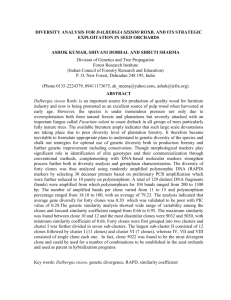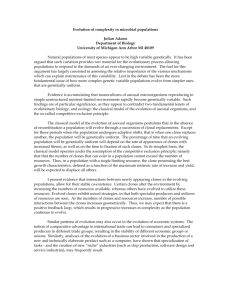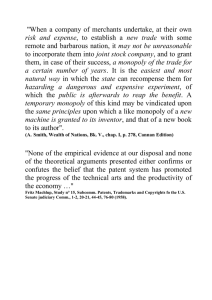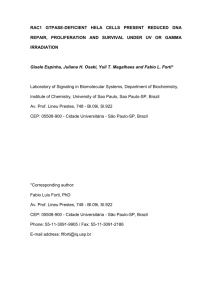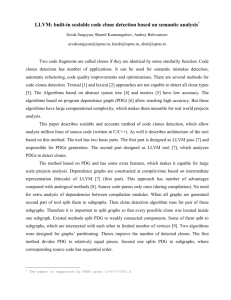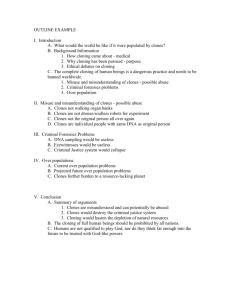Document 12787610
advertisement
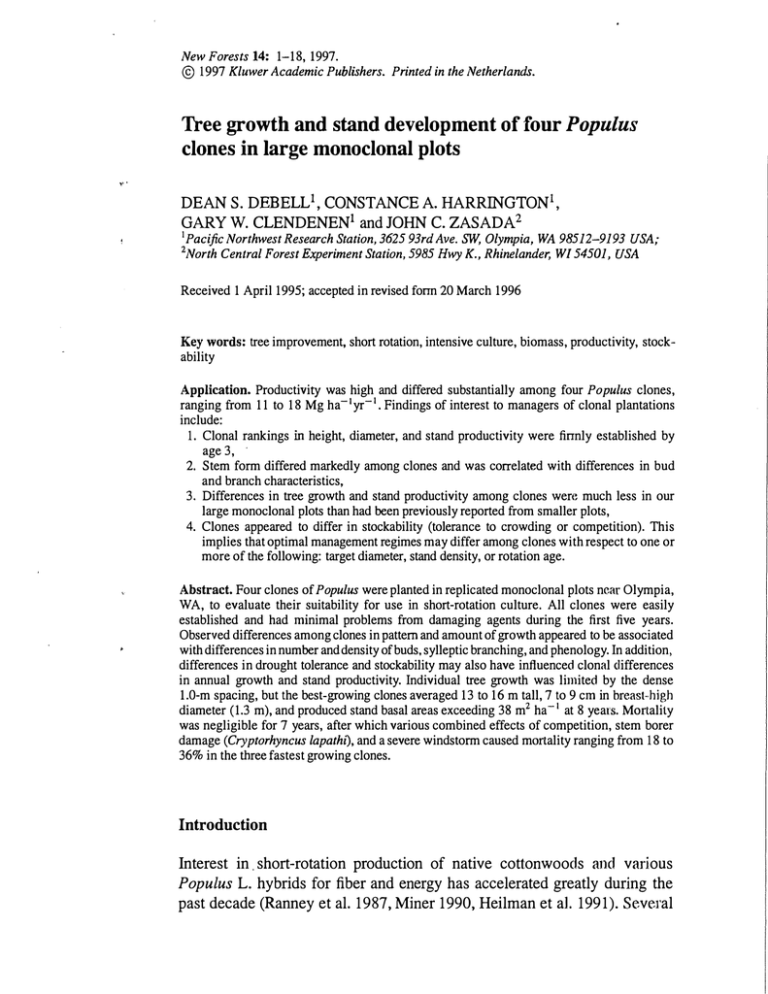
New Forests 14:
1-18, 1997. © 1997 Kluwer Academic Publishers. Printed in the Netherlands. Tree growth and stand development of four Populus
clones in large monoclonal plots
"
.
DEAN S. DEBELLl, CONSTANCE A. HARRINGTONl,
GARY W. CLENDENENl and JOHN C. ZASADA2
1 Pacific Northwest Research Station, 3625 93rd Ave.
sw,
Olympia, WA 98512-9193 USA;
2North Central Forest Experiment Station, 5985 Hwy K., Rhinelander, WI 54501, USA
Received 1 April 1995; accepted in revised fonn 20 March 1996
Key words: tree improvement, short rotation, intensive culture, biomass, productivity, stock­
ability
Application. Productivity was high and differed substantially among four Populus clones,
ranging from 11 to 18 Mg ha-I yr-I Findings of interest to managers of clonal plantations
include:
1. Clonal rankings in height, diameter, and stand productivity were finnly established by
age 3,
2. Stem form differed markedly among clones and was correlated with differences in bud
and branch characteristics,
3. Differences in tree growth and stand productivity among clones were much less in our
large monoclonal plots than had been previously reported from smaller plots,
4. Clones appeared to differ in stockability (tolerance to crowding or competition). This
implies that optimal management regimes may differ among clones with respect to one or
more of the following: target diameter, stand density, or rotation age.
•
.
Abstract. Four clones of Populus were planted in replicated monoclonal plots near Olympia,
WA, to evaluate their suitability for use in short-rotation culture. All clones were easily
established and had minimal problems from damaging agents during the first five years.
Observed differences among clones in pattern and amount of growth appeared to be associated
with differences in number and density of buds, sylleptic branching, and phenology. In addition,
differences in drought tolerance and stockability may also have influenced clonal differences
in annual growth and stand productivity. Individual tree growth was limited by the dense
1.0-m spacing, but the best-growing clones averaged 13 to 16 m tall, 7 to 9 cm in breast-high
diameter (1.3 m), and produced stand basal areas exceeding 38 m2 ha-I at 8 years. Mortality
was negligible for 7 years, after which various combined effects of competition, stem borer
damage (Cryptorhyncus lapathi), and a severe windstorm caused mOltality ranging from 18 to
36% in the three fastest growing clones.
Introduction
Interest in short-rotation production of native cottonwoods and various
Populus L. hybrids for fiber and energy has accelerated greatly during the
past decade (Ranney et al. 1987, Miner 1990, Heilman et al. 1991). Several
2
large forest products corporations have made or are considering substantial
investments in poplar tree farms in the Pacific Northwest. Farmers and other
land owners are assessing opportunities for producing and marketing cotton­
wood from their smaller acreage (Associated Forest Products Consultants,
Inc. 1990). Productivity can be very high, provided that suitable clones
are planted on proper sites and appropriate cultural techniques are applied.
Many clones have been selected for planting based on performance in small
evaluation plots, but few comparative data have been published on growth
and yield in larger monoclonal plots where competition from neighboring
clones had little or no influence on absolute or relative form, structure, and
growth of the individual clones. This report describes survival, growth, stem
characteristics, and stand development to age 8 of four Populus clones
planted at 1.0-m spacing in monoclonal plots having sufficient size and bor­
ders to limit effects from trees growing in adjacent plots. To aiq in interpreting
clonal differences in stand productivity, detailed measurements were taken
in some years to assess leaf area, bud populations, branching characteristics,
and the phenology of height and diameter growth.
Methods
The study was established in cooperation with the Washington State Depart­
ment of Natural Resources at the Meridian Seed Orchard located 12 km east
(lat. 47° 0' N, long. 122° 45' W ) of Olympia, Washington. The low-elevation
site (50 m) has a mild climate with an average growing season of 190 frost-free
days and a mean July temperature of 16° C. Annual precipitation is approxi­
mately 1290 mm, falling mostly as rain from October through May; summers
'are periodically dry. The soil is Nisqually loamy fine sand (a sandy, mixed,
mesic Pachic Xerumbrept); it is a deep, somewhat excessively drained,
medium acid (pH 5.6) soil formed in glacial outwash, and would not be con­
sidered suitable for Populus growth without irrigation. Nearby unmanaged
land is occupied by either prairie vegetation or Douglas-fir (Pseudotsuga
menziesii (Mirb.) Franco) and several hardwood shrubs, depending on fire
history. The land is level and was previously farmed for strawberry and hay
crops. It was prepared for planting by plowing and disking in winter 1985-86.
The study compared four Populus clones planted in monoclonal plots at
1.0-m square spacing; all four clones were under consideration for use in
biomass plantations. Two clones were collected by Stettler and his colleagues
(Weber et al. 1985, Quinsey et al. 1991) in wild stands of native black
cottonwood (P. trichocarpa Torr. & Gray); clone 7-75 was collected at 91-m
elevation along the Puyallup River near Orting, Washington, and clone 8-81
was obtained at 7-m elevation in the Nisqually River Delta which is near
3
the s tudy s ite. Early growth of the Orting and Nis qually clones was above
average for black cottonwood clones in initial s creening trials (Heilman and
Stettler 1985). The other two clones were Populus hybrids ; clone 11-11
was a P. trichocarpa x P. de Itoides Bartr. ex Mars h. var. deltoides hybrid
developed and tested by the University of Washington/Washington State
University Poplar Research Program (Heilman and Stettler 1985, Quins ey et
al. 1991); clone 0-01 was a Populus hybrid (taxonomic identity unknown,
but s us pected to be either P. trichocarpa x P. nigra L. or P. trichocarpa x
P. angustifolia James ) developed originally at the Univers ity of Idaho and
s ubsequently s elected from a Canadian planting by Dula's Nursery of Canby,
Oregon (Dula 1984).
Each clone was tested in three plots of 100 meas urement trees planted
at 1. 0-m x 1. 0-m s pacing, s urrounded on all s ides by at leas t four rows
of similarly s paced trees. Plots of the two hybrid clones (11-11 and D-Ol)
were randomly located within three blocks of a larger s tudy that compared
"woodgrass " (i. e. , <0.3-m s pacing, coppiced annually) and wider-s paced
systems (square spacings of 0. 5-, 1. 0-, and 2. 0-m) for biomas s production
(DeBell et al. 1993). Plots of the two native black cottonwood clones (7-75
and 8-81) were randomly positioned within a s atellite block immediately
adjacent to the larger s tudy. An additional 20 cuttings of clone 11-11 als o were
planted in the s atellite block. Conditions of the s oil and other environmental
characteris tics , however, were very uniform among all blocks and plots .
The clones were es tablis hed by hand planting unrooted, hardwood cut­
tings in late April 1986. All cuttings were 30-cm long and had a minimum
upper diameter of 1 cm; they were planted 20-cm deep with at leas t two
healthy axillary buds remaining above ground. Previous experience indicated
es tablishment s ucces s (i. e., survival and early growth) was poor if cuttings
did not have at leas t one healthy bud above ground (Radwan et al. 1987).
Requiring two above-ground buds res ulted in a s mall additional increas e in
establishment s ucces s but also increas ed the prevalence of multiple s tems . At
the end of the firs t growing seas on, all multiple-s temmed plants were pruned
to one stem and any positions occupied by dead trees were replanted with
unrooted cuttings ; this res ulted in stands compos ed solely of s ingle-stemmed
trees and with all planting spots occupied.
Supplemental nutrients and water were provided uniformly in plots of
all treatments to enhance survival and growth. A preplanting application of
mixed or complete fertilizer (16-16-16) provided the equivalent of 100 kg
ha-1 nitrogen, 43 kg ha-1 phos phorus, and 83 kg ha-l potas sium. Additional
nitrogen fertilizer (ammonium nitrate) was applied at 100 kg N ha-1 in May
1988 and again in March 1992. Plots were irrigated throughout each surnmer
by a drip s ystem; amounts applied averaged 400-600 mm per growing season
4
but varied from 260 to 1200 mm; yearly differences were associated more
with scheduling conflicts and malfunctioning of irrigation pumps than with
differences in potential evapotranspiration. All plots were kept free of weeds'
during the first year by tilling and hoeing; in the second and third year,
sporadic weed patches were controlled by spot applications of herbicides and
hoeing.
Tree survival, total height, and stem diameter were evaluated at the end
of each of 8 growing seasons on the central 100 trees in each plot, and any
tree damage or unusual conditions were noted. Height and diameter were also
measured periodically on 25 trees per plot to assess seasonal growth patterns.
Information on basal diameter (measured at stem height ofO.3m) was obtained
for all years, and breast-high diameter (dbh) was also measured after mid­
season in the second year. Figures presenting periodic growth utilize basal
diameter as it is available for all periods. Cumulative basal area over time and
diameter at age 8 are presented based on measurement at breast height (1.3 m)
to facilitate comparisons with standard forestry measurements. Breast-high
diameters at the end of the first year were estimated from height measurements
and dbh-height relationships derived from data collected in June of the second
year.
Indices for lower-stem taper were calculated from basal and breast-high
diameters (basalldbh), and slenderness was characterized with the ratio of
height/basal diameter. After the first, second, and third seasons, numbers of
buds and branches were counted for each annual height increment. Such data
provided information on initial bud populations, development of sylleptic and
proleptic branches, and branch longevity. Observations were recorded on leaf
phenology, insect and disease problems, and wind damage.
Yields for ages 1 through 5 were estimated from oven-dry biomass
component equations applied to basal diameter and height measurements
of individual trees. The equations were developed via destructive sampling
of trees at the end of years 1 through 5; selected trees were from buffer rows
and were representative of the range of sizes for each clone. Equations of the
form, Ln(Y) = f(basal diameter, height, and age), were fit independently for
each clone. Dry weights of stems and branches were estimated by separate
equations. Coefficients of determination (R2) between predicted and mea­
sured values ranged from 0.906 for branch weight of clone 8-81 to 0.999 for
stem weight of clone 7-75. Stem, branch, and leaf weights were estimated
by separate equations; stem and branch weights were summed to provide
above-ground dry woody biomass. Above-ground woody biomass estimates
for all trees on each plot were summed, and the resulting plot sums were
expanded to woody biomass yield per hectare. Destructive sampling of all
5
clones did not occur after year 5; thus, stand growth parameters beyond age
5 are limited to height, diameter, and basal area.
Leaf area index was estimated by determining the projected area of a
sub-sample of leaves from each biomass sample tree using an area meter
(LICOR 3100). Leaf area per tree was then estimated via area/leaf weight
relationships; it was expanded to a per unit area basis by summing estimates
for all trees on the plot; total leaf area (m2) was then divided by ground
surface area (m2) to provide the dimensionless leaf area index (LAI).
Annual diameter growth (per tree) and basal area growth (per hectare)
were plotted against a competition index calculated by summing the product
of basal diameter (m2) x height (m) (both measured at the beginning of
the growth year) for all trees on the plot and expanding it to a per hectare
value. This allowed comparison of clonal growth rates at similar levels of
competition, even when the same competition level was reached in different
years.
Statistical comparisons required special consideration because the four
clones had been assigned to plots randomly as components of two adjacent
experimental plantings rather than as one experiment. We first examined the
data for differences in growth performance among blocks and concluded that
there were none. Two approaches were used to arrive at that determination:
(1) analyses of variance for height and diameter of clones 11-11 and D-O 1
indicated that block effects were non-significant for both height (p = 0.66)
and diameter (p = 0. 53); and (2) graphic comparisons revealed that early
growth of 20 trees of clone 11-11 in the satellite block (composed primarily
of replicated plots of clones 7-75 and 8-81) was essentially identical to mean
growth of clone 11-11 in the other three blocks. Given the lack of evidence
for environmental or growth differences among blocks, we examined mean
tree and plot data via standard analysis of variance procedures assuming a
completely randomized design (i.e., block was not considered as a source
of variation). W here appropriate, clonal treatment means were compared by
the Ryan-Einot-Gabriel-Welsch multiple-stage test (Ramsey 1978) (using p
< 0.05 to judge significance) and standard deviations were calculated. These
data are displayed in tables or figures to illustrate trends in development of
the clonal plantings.
Results and discussion
Survival and growth during the establishment year. Cuttings of all four
clones produced roots and shoots very well, and survival at the end of the first
growing season and prior to replacement planting was 96 percent or higher.
The two black cottonwood clones (7-75 and 8-81) averaged 2.4 m in height
-
6
and 2.2 cm in basal diameter; hybrid clone 11-11 was 2.3 m tall and 2.2 cm
in basal diameter, but hybrid clone 0-01 was considerably shorter in height
(1.7 m) and smaller in basal diameter (1.3 cm). Above-ground dry woody
biomass averaged 2.9 Mg ha-1 for the two black cottonwood clones and
hybrid 11-11; whereas, clone 0-01 produced only 1.2 Mg ha-1.
Patterns of height and diameter growth. - Annual increments of height
and diameter growth are shown by clone in Figure 1 for all trees that survived
through age 8. By the end of the second year, height and diameter of hybrid
clone 11-11 were greater than either of the black cottonwood clones, which in
turn were larger than hybrid clone D-Ol. Ranking by size thereafter remained
similar through age 8 years, except that clone 7-75 was surpassed eventually
by clone 8-81 in both height and diameter and was equaled by clone 0-01
in diameter. Annual growth of all clones declined as trees became older
and larger and inter-tree competition became more intense, but growth of
the black cottonwood clones accelerated somewhat for diameter during the
seventh year and for height in the eighth year, presumably in response to
increased crown differentiation within the stands. Relative growth of the
different clones differed among years and over time as follows. During the
third through the seventh years, annual growth of hybrid clone D-Ol was
equal to or greater than either black cottonwood clone (7-75 or 8-81) in both
height and diameter, and its growth during the fifth year (1990) was slightly
greater than that of clone 11-11. Diameter growth of clone 8-81 was equal
to or greater than clone 11-11 in the first, third, seventh, and eighth years.
Differences among clones in magnitude and trends in annual growth can be
attributed in part to differences in leaf and growth phenology and prevailing
weather conditions. Clones 0-01 and 7-75 commonly broke bud in early
March; clone 8-81, by mid-March; and clone 11-11, at the end of March or
in early April. Terminal bud-set occurred in early to mid-September in clone
D-Ol, and foliage soon yellowed and dropped. Terminal growth continued
into October for the two black cottonwood clones and hybrid 11-11, and
green foliage sometimes remained on the latter clone into early November.
Such differences in shoot and leaf development are reflected in seasonal
patterns of periodic daily height and diameter growth of dominant and co­
dominant trees as shown in Figure 2 for the third growing season - a year
of average temperature and moisture conditions. By mid-May, height growth
of all clones had accelerated; all attained maximum height growth of 2 to
3 mm per day in July. Height growth of clone D-Ol then declined rapidly
whereas growth of the two black cottonwood clones and hybrid clone 11-11
continued at a near maximum rate into September. In general, diameter growth
of the Populus clones peaked earlier than height growth. Although this finding
may run counter to phenological trends commonly found for other onifers
7
18
a.
O �--��--�---J�--�
7-75
8-81
11-11
D-01
YearD
Clone
2m3
5
52S2j6
11-11
8-81
7-75
D-01
4
7_8
Figure 1.
Eight-year cumulative growth in height and basal diameter of trees surviving to year
8 by clone.
and hardwoods in temperate zones, it is consistent with the pattern for red
alder (Alnus rubra Bong.), another species with a "sustained growth" habit
(Zimmerman and Brown 1971), growing at the study site and other locations
(DeBell and Giordano 1994).
There were also differences in diameter growth patterns among clones.
Diameter growth of clone D-Ol peaked earlier than that of the two black
cottonwood clones. Diameter growth of the two black cottonwood clones
and, to a lesser extent, hybrid clone 11-11 remained at a high level later
into the season whereas clone D-Ol declined rapidly after its peak in mid­
May. When moisture was abundant and temperatures were warm early in
the growing season and conditions later in the season were unfavorable (Le.,
dry or unusually cool), growth of clone D-Ol was relatively better than
growth of the other clones. Conversely, adverse growing conditions during
the early season followed by more favorable late season temperahlfe and
moisture conditions favored growth of the other clones. Similar though less
pronounced differences existed between the two black cottonwood clones
8
00 b. lJametel
Clone
* 7-75
o 8-81
o 11-11
6. 0-01
N'R
tlAy
JUN
JUl.
lUG
SEP
ocr
N'R
tlAy
JUl.
lUG
SEP
ocr
Growth Period
Figure 2.
Phenology of height and basal diameter growth of four Populus clones planted at
1.0-m spacing.
and hybrid clone 11-11, but relative growth perfonnance probably is more
specifically influenced by the duration of drought stress as the hybrids of
P. trichocarpa and P. deltoides have greater stomatal control and drought
resistance than black cottonwood clones (Schulte et al. 1987).
Although general declines were expected with age, growth was less than
expected in the fourth (1989) and sixth (1991) years (Figures la and b), with
the apparent reduction being greater for the two black cottonwood clones and
clone D-O 1 than for clone 11-11. Weather and irrigation records show that
during the March-June period in both 1989 and 1991, precipitation was below
nonnal and irrigation inputs were very low because of equipment problems.
Total input of water during the early growing season of 1989 and 1991 was
at least 50% less than that occurring during the first three years of growth
(1986-1988) and in the fifth (1990) and seventh (1992) years.
Development of buds, branches, and leaf area. - Height and diameter
growth of the clones prior to the onset of intertree competition were strongly
influenced by the dynamics of bud and branch populations and associated
effects on the development of leaf area (Table 1). Although the"clones pro­
duced similar numbers of buds on the main stem during the establishment
year, substantial differences occurred in the extent of sylleptic branching and
development of leaf area. A branch is classified as sylleptic if it develops and
elongates during the same growing season the bud is fonned. If the bud does
not develop into a branch until the following growing season, the branch is
classified as proleptic. The two black cottonwood clones and clone 11-11 had
many more sylleptic branches and at least three times the leaf area of clone
D-O 1 by the end of the first growing season. The total number of branches
per tree produced by clone D-O 1 during the first two years was comparable to
9
those produced by the other clones; however, since almost all of its branches
were proleptic, they did not contribute to the development of leaf area until the
second year. In addition, proleptic branches have been shown to export a
lower percentage of photosynthate than sylleptic branches (Hinckley et al.
1992, Scarascia-Mugnozza 1991). The combination of the differences in
pattern of leaf area development and the carbon export behavior of the two
branch types has been suggested as conferring a potential productivity advan­
tage to clones with greater production of sylleptic branches (Hinckley et al.
1992). Although the degree of syllepsis may not be the only contributing
factor, differences in second year sylleptic branching and leaf area were con­
sistent with subsequent growth rankings among the four clones (Table 1,
Figure 1). For example, clone 11-11 produced more buds and more sy lleptic
branches than any other clone; it produced 39 to 124% more leaf area and
maintained its size ranking. A shift in rank occurred between the two native
clones. Clone 7-75 outgrew clone 8-81 during the first two seasons, but
by the end of the second year the greater sylleptic branching of clone 8-81
resulted in greater leaf area. By the end of the third season, these two black
cottonwood clones were very similar in height but clone 8-81 was slightly
larger in diameter. By the fifth season, clone 8-81 had surpassed clone 7-75
in both height and diameter.
Number of branches retained on the first year's height increment was
greater for clone D-O 1 than for the other three clones. After the third growing
season, little branch mortality had occurred on the lower portion (first year's
growth) of clone D-Ol whereas essentially all branches had died on the other
clones. .
Stem form. - The clones also differed in slenderness ratio (height/basal
diameter) and lower-stem taper (basal diameter/dbh) (Table 2). At age 2,
clones 7-75, 8-81, and 11-11 had smaller values for lower stem taper and
higher slenderness ratios than D-O 1. The values for lower stem taper at
age 2 were negatively correlated (r = -0.92; p = 0 07) to the percentage of
buds producing sylleptic branches. Thus, the higher the percentage of buds
becoming sylleptic branches, the less tapered the tree bole. This effect is
consistent with the previously-mentioned observation that sylleptic branches
export a higher percentage of photosynthate than proleptic branches (Hinckley
et al. 1992, Scarascia-Mugnozza 1991). Such differences among clones were
reduced over time as the live crowns lifted and lower stem growth was
influenced by more complex interactions of branch type, age, and crown
position, including clonal differences in branch retention. Slenderness ratios
have increased over time as would be expected at this dense spacing. Clone
8-81 grew proportionately more in diameter than in height between years
.
10 Table 1. Tree height, axillary buds on the current terminal shoot, branching characteristics, and leaf area per tree during first and second year growth of four Populus
clones.
Characteristic
7-75
Clone
11-11
8-81
D-01
2.4a
1.7b
First year
46.4a
2.3a
47.2a
48.0a
20.0a
14.2a
1.6b
1.7a
1.6a
1.7a
0.5b
Proleptic branches (no.)
Terminal growth (m)
15.7b
21.3b
3.0b
5.8c
3.8a
4O.9a
1.9c
Buds or current terminal (no.)
Buds producing sylleptic branches
44.3b
47.2b
59.5a
42.7b
22.3a
O.OC
10.6
3.4bc
9.9b
21.0
3.7b
37.5
5.4a
0.0
2.4c
35.0a
LOb
38.7a
2.0b
6.7b
O.Ob
4O.7a
36.1a
Height (m)
Buds (no.)
2.4a
44.8a
Sylleptic branches (no.)
Leaf area (m2)
20.6a
Second year
3.4ab
(no.)
4.7bc
(%)
Leaf area (m2)
Branch retention
Total branches on first year height
increment at end of
2nd year
3rd year
O.OS.
,��--
Note: Values in a row followed by the same letter did not differ at p
-.. -
,--
Table 2. Slenderness ratio and lower stem taper by clone at ages 2 and 8. Slendemess
ratio
height in meters -+- diameter at 0.3 m in centimeters. Lower stem taper
diameter at 0.3 m -+- diameter at 1.3 m.
=
Clone
=
Slenderness ratio
Lower stem taper
Age 2
Age 8
Age 2
7-75
8-81
l .46a
lA1a
1.70a
1.59b
1.39b
1.13b
U8a
11-11
lAl a
1.17b
1.72a
1.5l c
1.18c
1.66a
1.06c
1.20a
D-01
1.35bc
Age 8
Note: Values in a column followed by the same letter do not differ at p S; 0.05.
2 and 8 than 11-11 and thus shifted in rank from first to third in relative
slenderness.
Leaf area indices and accumulation of woody biomass and basal area.
Leaf area expanded rapidly in the second and third growing seasons, nearing
-
11
or reaching a peak in all clones during the third year (Figure 3a). Leaf area
index attained maxima of 7.7 and 7.8 for hybrid clone 11-11 at age 3 and 4
and then declined to 6.4 at age 5. Maximum leaf area indices for the other
three clones ranged from 5.0 to 5.7. Leaf area indices for clones 11-11, 7-75,
and 8-81 had declined by age 5, averaging about 20 percent lower than the
maxima. Leaf area index of clone D-O1, however, changed relatively little
after attaining a plateau of about 5.0 at age 3.
Above-ground woody biomass production accelerated markedly during
the third season, and rates were more or less maintained through the fifth year
(Figure 3b). At 5 years, total production was 56 Mg ha-1 for D-Ol, 63 and
66 Mg ha-1 for 7-75 and 8-81, and 91 Mg ha-1 for 11-11. Mean annual
increments thro gh age 5 were 11 Mg ha-1 for D-Ol, 13 Mg ha-1 for 7-75
and 8-81, and 18 Mg ha-1 for 11-11. Subsequent evaluations of biomass
production of clones 11-11 and D-Ol through year 7 in adjacent spacing
trials revealed that current annual biomass increment had peaked in the 1.0-m
spacings in the 4th year for clone 11-11 and in the 5th year for clone D-Ol.
The decline was so great in clone D-O1 that mean annual increment also
culminated in the 5th year; mean annual biomass increment did not peak
in clone 11-11, however, until the 6th year. Because height and diameter
increment patterns of the two black cottonwood clones were intermediate
between those of the two hybrids, we suspect that similar biomass growth
trends occurred and that mean annual biomass increments at 5 years repre­
sented a near maxima for all four clones in the study environment. Moreover,
our measured rates of production for clone 11-11 are very similar to those
obtained in 7-year-old research trials (17 Mg ha-1 yr-1 ) and operational
plantings (12 to 17 Mg ha-1 yr-1) by James River Corporation in the lower
Columbia River Valley (Schuette 1995, pers. comm.).
The clones also differed in the amount and proportion of branches in th!;!
woody biomass yields. Clone D-O1 had the most branches ('"10 Mg ha-1 ),
and they comprised about 18 percent of the woody biomass. Branch weights
for other clones were 5 to 7 Mg ha-1 and accounted for only 7 to 10 percent
of the woody biomass.
Basal area growth accelerated during the second and third season (Figure
3c). Rate of accumulation declined slightly thereafter, but basal area of all
clones continued to increase through the seventh season. Accumulated basal
area of two clones, however, was lower for different reasons at the end of the
eighth season. Losses in basal area of hybrid clone 11-11 were caused by
combined effects of borer damage and a severe windstorm; losses for clone
7-75 were associated primarily with competition-related mortality. Highest
basal areas per hectare attained at age 7 for clones 11-11 and 7 75 were 48
12
9
8
a.
7
(\J
......
6
I
E
5
(\J
4
E
3
"--'
2
1
0
3
2
0
A ge
100 b .
4
5
4
5
(yrs) ...... ,...
I
<tl 80 ..c OJ
"--'
60 en en
<tl 40
E
0
:0 c
0
20 0
3
2
0
Age
60 c .
(yrs)
.--__________
________c
...... ,...
I 50
<tl ..c 40
(\J
E
"--'30 <tl
Q.)
'<tl
20
CO
en
<tl 10
en
0
0
Figure 3.
2
3
Age
4
5
6
7
8
(yrs) Accumulation of leaf area (a), above-ground woody biomass (b), and basal area (c)
in stands of four Populus clones (legend as in Figure 2b). Basal area based on diameter at 1.3
m. Standard errors shown as vertical lines.
13 m2 and 31 m2, respectively, whereas highest basal areas attained at year 8 for
clones 8-81 andD-Ol were 39 m2 and 33 m2•
Relative tolerance to intertree competition. - Mean tree growth in height
and diameter peaked in the second or third year, and, in general, annual basal
area and, presumably, woody biomass growth per hectare had begun to decline
by the fifth year for all clones planted at the 1.0-m spacing. Such declines in
mean tree and per hectare growth in these young plantings are largely due
to the development of stress associated with intense intertree competition. In
order to determine whether differences existed among clones in tolerance to
competition or "stockability" (DeBell et al. 1989), measures of annual mean
tree (diameter) and per hectare (basal area) growth were plotted against a
stand competition index (Figure 4a and 4b). With the exception of clone 8-81
in year 7 or 8, growth of hybrid clone 11-11 exceeded that of other clones at
similar levels of competition. For other clones, annual basal diameter growth
per tree began to decline at lower levels of competition index, and the decline
was more abrupt than for hybrid 11-11 (Figure 4a); the same is true of basal
area growth per hectare (Figure 4b). The sharp decline in apparent basal area
growth during the last period (year 8) for clones 11-11 and 7-75 is due to
mortality discussed in the previous section on basal area accumulation. Thus,
clone 11-11 not only grows more rapidly than other clones, it also has the
capacity to tolerate and grow more rapidly at higher levels of stand density.
Both traits - individual tree growth and stockability - are important to stand
productivity.
Tree and stand characteristics at 8 years. - Current annual increment in
basal area and above-ground woody biomass peaked in all clones, and total
accumulation in basal area (and presumably biomass) has declined in two
clones. Tree survival at the end of the eighth year ranged from 68 to 95 percent
(Table 3). Little mortality had occurred in any clone through age 7 years, but
the two native clones and hybrid clone 11-11 suffered considerable mortality
during the eighth growing season. Clone 11-11 was clearly superior to all
other clones in height and diameter. The sizable differences among clones in
mean basal area at age 8 were not statistically significant Cfable 3), primarily
because the values are strongly influenced by recent mortality and this was
not distributed uniformly among the replicate plots of individual clones.
Damaging agents. - During the first eight growing seasons, insect and
disease problems were generally minimal. Aphids appeared on all clones but
soon were controlled by an expanding population of ladybugs. Melampsora
rust developed during late summer on the two native clones (7-75 and 8--81)
and may partially account for their poorer subsequent growth in comparison
to clone 11-11 which remained essentially free of rust. Some lateral buds
were destroyed on all clones by eriophyd mites (Eriophyes parapopuU). This
14
3
::I
a.
o
......
,-
I
100
200
300
400
500
600
700
800
Competition Index (m 3 ha -1 )
900 1000 1100
20 b.
,-
I
CU
10
.c
o
.c
C\J
OJ
CU
cu
-10
cu
(j)
- 20
__
o
Figure 4.
100
.--.__-.__
__
200
300
400
.-__r--.__-.__'-__
__
500
600
700
800
Competition Index (m 3 ha -1 )
900 1000 1100
Current annual diameter growth per tree (a) and basal area growth per hectare (b) in
relation to an index of stand competition (:E D2H in m3ha-l) at the beginning of the growing
season for four Populus clones (legend as Figure 2b). Standard errors shown as vertical lines.
15
Table 3. Survival, height, diameter, and stand basal area of four Populus clones
planted at 1.0-m spacing at age 8 years.
Clone
Survival
-- % --
7-75
68a
Height
Diameter
O.3 m
--m --
12.8bc
Basal area
1.3 m
- - - cm - -
__
m2ha-1 --
7.6b
6.8b
26.2a
8-81
85a
13Ab
8.6ab
7.3b
38.1a
11-11
D-01
79a
95a
16.1a
11.1c
9.5a
9.0a
6Ab
45.5a
32.9a
7.6b
Note: Values in a column followed by the same letter do not differ at p
0.05.
damage occurred primarily on the ends of lower lateral branches and was
roughly proportional to the timing of budset (damage greatest on D-Ol,
intermediate on 7-75 and 8-81, and least on 11-11).
Heavy infestations of the poplar-and-willow borers (Cryptorhynchus
lapathi) were observed after the fifth year, especially in clone 11-11. Obser­
vations made in adjoining plots of other spacings suggested that infestations
were greater in stands having higher density or more intense competition.
By the end of the seventh growing season, 27 and 16 percent of the trees in
clones 11-11 and 7-75 had been attacked, respectively, whereas only 8 and
5 percent of clones D-Ol and 8-81 were affected.
After trees were measured at the end of the seventh growing season, a
severe windstorm occurred in the area and resulting damage varied signif­
icantly among clones. Hybrid clone D-Ol and the two native clones (7-75
and 8-81) were basically unaffected; although some trees of these clones had
broken branches or tops, none were windthrown or seriously broken. Clone
11-11, however, suffered substantial damage; some stems were windthrown
or "lodged" but most damaged stems were broken at 0.2 to 1.0 m above
ground. About 7 percent of all measurement trees of clone 11-11 in the 1.0-m
spacing suffered such breakage, which occurred primarily in stem segments
with evidence of considerable borer activity, and thus considerably weakened
structure.
Conclusions and implications
All four clones were easy to establish with unrooted hardwood cuttings at the
experimental site under the imposed management regime and survival was
excellent. Growth differences, however, were manifested early and clonal
rankings were established by age 3. Bud and branching characteristics were
16 closely related to leaf area development, tree growth rates, and stem form of
the four clones tested.
Competition in these 1.0-m spaced plantings was such that growth in
height and diameter of all clones declined substantially by the fourth growing
season. Subsequent work in adjacent spacing trials involving clones 11-11
and D-O1 only indicated that mean annual increment peaked during the sixth
season for clone 11-11 and during the fifth year for clone D-O 1. Given that
declines in height and diameter increment of the two black cottonwood clones
were intermediate between clones 11-11 and D-O1, it seems reasonable to
rank the clones based on productivity attained through year 5. Thus, clone
11-11 with 18 Mg ha -1 yr-1 was about 40% more productive than the two
black cottonwood clones and more than 60% more productive than clone
0-01.
Other research (DeBell et al. 1996) and operational experience (Schuette
1995) suggest that these productivity values are indicative of the levels of
mean annual production that may be obtained at wider spacings with slightly
longer rotation ages. Our productivity values, however, are lower and differ­
ences among clones are less than values reported previously. Mean annual
production values determined at age 5 by Heilman and Stettler (1985) for
clone 11-11 and the population sources from which clones 7-75 and 8-81
were derived were about 28 and 16 Mg ha -1, respectively. These authors
appropriately acknowledged that clonal interactions among adjacent 9-tree
plots exaggerated differences between high and low producers. Although the
small plots established in most genetic trials are necessary (and useful) for
screening large numbers of clones, they do not provide adequate informa­
tion on per hectare productivity or on relative productivity differences among
clones selected as appropriate for operational use. More accurate definition of
such differences may be important when other factors, such as susceptibility
to damaging agents or wood quality, may be significant considerations.
PIottings of annual growth in relation to stand competition indices sug­
gested that stockability differences (tolerance of crowding or competition)
exist among the clones. The potential importance of such differences to
stand productivity merits additional investigation over longer time periods
and with additional clones. Any finding of substantial differences in stock­
ability implies that optimal management regimes may differ among clones
with respect to one or more of the following: target diameter, stand density,
or rotation age. Moreover, given the same management regime, clones
having higher stockability offer greater flexibility for extending rotation
length because yield reductions due to mortality or growth deceleration will
be lower than for clones having lower stockability.
17 Pests and weather conditions had differential influences on the four clones
despite the short time involved in our evaluation. The most productive clone
(11-11) was resistant to the native Melampsora rust and least affected by
drought, but was the most susceptible to borer infestation and wind damage.
Such differences could attain considerable importance in some locations,
particularly with longer rotations.
Acknowledgments
This work is supported and coordinated by the Short Rotation Woody Crops
Program (now Biofuels Feedstock Development Program) of the U.S. Depart­
ment of Energy through Interagency Agreement No. DE-AI 05-81OR20914.
Technical support staff of the Pacific Northwest Research Station and Wash­
ington State Department of Natural Resources provided valuable assistance
in collection and analysis of data. Drs. Richard Hall, Paul Heilman, Brian
Stanton, and Gerald Tuskan provided useful review comments on an earlier
draft of the manuscript.
References
Associated Forest Products Consultants, Inc. 1990. A study of marketing prospects for hybrid
cottonwood grown in southwest Washington by private landowners. 81 pp.
DeBell, D. S., Clendenen, G. W. and Zasada, J. C. 1993. Growing Populus biomass: comparison
of woodgrass versus wider-spaced short-rotation systems. Biomass and Bioenergy 4{5):
305-313.
DeBell, D. S., Hanus, W. R. and Whitesell, C. D. 1989. Stockability: a major factor in
productivity differences between Pinus taeda plantations in Hawaii and the southeastern
United States. Forest Science 35(3): 708-719.
DeBell, D. S., Clendenen, G. W., Harrington, C. A. and Zasada, J. C. 1996. Tree growth and
stand development in short-rotation Populus plantings: 7-year results for two clones at
three spacings. Biomass and Bioenergy 11(4): in press.
Dula, J. C. 1984. Woodgrass production for energy application. In Proceedings of the 2nd
Technical Review Meeting, Energy from Biomass: Building on a Generic Technology
Base. 185 pp. Argonne National Laboratory, Wilsonville, OR, 23-25 April 1984.
Heilman, P. E., and Stettler, R E 1985. Genetic variation and productivity of Populus tri­
chocarpa and its hybrids. II. Biomass production in a 4-year plantation. Canadian Journal
of Forest Research 15: 855-859.
Heilman, P. E., Stettler, R. E, Hanley, D. P. and Carkner, R W. 1991. High yield hybrid poplar
plantations in the Pacific Northwest. PNW Ext. Bull. No. 356. WSU Coop. Extension,
Puyallup, WA. 32 p.
Hinckley, T. M., Braatne, J., Ceulemans, R, Clum, P., Dunlap, J., Newman, D., Smit, B.,
Scarascia-Mugnozza, G. and van Volkenburgh, E. 1992. 1. Growth dynamics and canopy
structure. pp. 1-34 In Mitchell, C. P., Ford-Robertson, J. B. and Sennerby-Forsse, L. (Eds).
Ecophysiology of Short Rotation Forest Crops. Elsevier Applied Science Publishers Ltd.,
London. 308 p.
18 Miner, C.L. 1990. Changing times for hardwoods, pp. 1-6 in Forestry Research West. Decem­
ber 1990. USDA Forest Service.
Quinsey, S., Stettler, R., Heilman, P., Delany, D., Fenn, R., Ager, A. and Glackin, P. 1991.
Clone register. University of Washington/Washington State University Poplar Research
Program. College of Forest Resources, University of Washington, Seattle. 115 pp.
Radwan, M. A., Kraft, J. M. and DeBell, D. S. 1987. Bud characteristics of unrooted stem cut­
tings affect establishment success of cottonwood. USDA Forest Service, Pacific Northwest
Research Station, Research Note PNW-RN-461. 8 p.
Ranney, J. W., Wright, L. L. and Layton, P. A. 1987. Hardwood energy crops: the technology
of intensive culture. Journal of Forestry 85(9): 17-28.
Scarascia-Mugnozza, G. 1991. Physiological and morphological determinants of yield in
intensively-cultured poplars (Populus spp.). Unpublished Ph.D. dissertation, University of
Washington, Seattle, WA. 189 p.
Schulte, P. J., Hinckley, T. M. and Stettler, R. F. 1987. Stomatal response of Populus to leaf
water potential. Canadian Journal of Botany 65: 255-260.
Weber, J. C., Stettler, R. F. and Heilman, P. E. 1985. Genetic variation and productivity of
Populus trichocarpa and its hybrids: I. Morphology and phenology of fifty native clones.
Canadian Journal of Forest Research 15: 384-388.
Zimmerman, M. H., and Brown, C. L. 1971. Trees - Structure and Function. Springer-Verlag,
New York. 336 p.
About This File: This file was cr4eated by scanning the printed publication.
Misscans identified by the software have been corrected; however, some mistakes
may remain.

